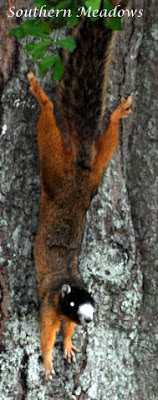Pitcher Plant
Today, Fer at my little garden in japan is hosting a carnival of favorite plants where garden bloggers are asked to showcase their favorite plant. What a dilemma. This is like asking me to pick a favorite child....IMPOSSIBLE! So I have decided to profile a plant which I have been fascinated with this past year....the pitcher plant (Sarracenia).
It is a spectacular plant. The pitchers are actually modified leaves with sealed bottoms. Insects are attracted to the pitchers because they mimic flowers. Notice that the color is more intense at the mouth of the plant.
Flies, bees, moths and other insects are lured inside then slip to the bottom of the trap where they drown and dissolve in the plant's digestive juices.
Fun Fact: Some pitcher plants are home to small caterpillars that use the inside of the plant to pupate and metamorphose into an adult moth.
In the spring the pitcher plant produces beautiful flowers which are harmless to insects and in fact contain pollen and nectar just like conventional blooms.
In the Southeast United States the pitcher plant is threatened by habitat destruction. The Atlanta Botanical Garden is the national collection holder for the genus Sarracenia as appointed by the North American Plant Collections Consortium. They showcase species found in natural bog habitats in the wild.
If you live in the area or are visiting Atlanta I highly recommend taking a tour of the gardens. The pitcher plants are best viewed April through October as they go dormant during the winter months. I am in the planning stage of installing a bog garden in my backyard and will certainly blog about it as it becomes a reality. Until then I am sharing photographs of pitcher plants that I have taken on Garden Tours and visits to various Botanical Gardens.
It is a spectacular plant. The pitchers are actually modified leaves with sealed bottoms. Insects are attracted to the pitchers because they mimic flowers. Notice that the color is more intense at the mouth of the plant.
Flies, bees, moths and other insects are lured inside then slip to the bottom of the trap where they drown and dissolve in the plant's digestive juices.
 |
| mosquito crawling up plant |
Fun Fact: Some pitcher plants are home to small caterpillars that use the inside of the plant to pupate and metamorphose into an adult moth.
In the spring the pitcher plant produces beautiful flowers which are harmless to insects and in fact contain pollen and nectar just like conventional blooms.
 |
| Pitcher Plant Bloom |
In the Southeast United States the pitcher plant is threatened by habitat destruction. The Atlanta Botanical Garden is the national collection holder for the genus Sarracenia as appointed by the North American Plant Collections Consortium. They showcase species found in natural bog habitats in the wild.
 |
| Sarracenia in natural bog habitat (ABG) |
If you live in the area or are visiting Atlanta I highly recommend taking a tour of the gardens. The pitcher plants are best viewed April through October as they go dormant during the winter months. I am in the planning stage of installing a bog garden in my backyard and will certainly blog about it as it becomes a reality. Until then I am sharing photographs of pitcher plants that I have taken on Garden Tours and visits to various Botanical Gardens.


.png)
